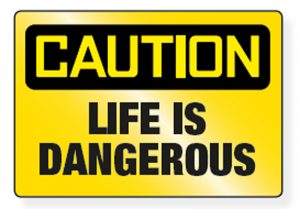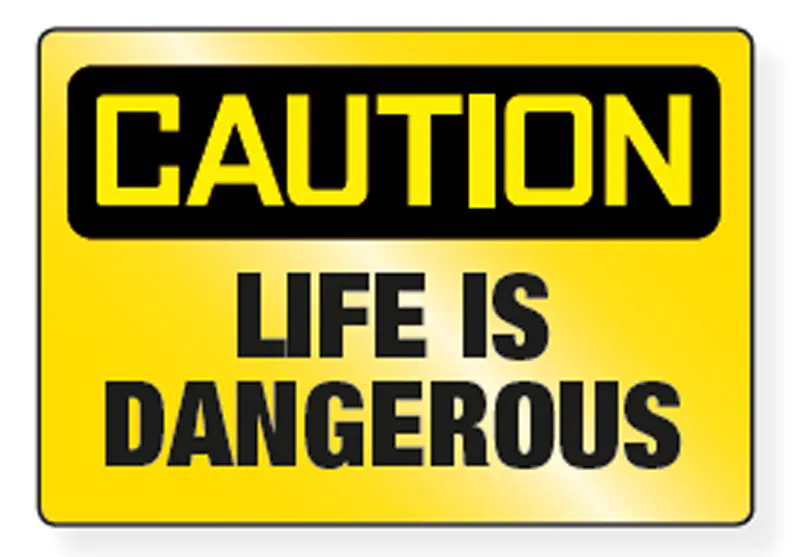HEY, watch this. I am about to write the most blindingly obvious opening line in the history of S.W.A.T. Magazine:
Life is dangerous.
There it is. Something everybody knows from the moment they’re out of diapers—maybe even before that. Life. Is. Dangerous.
 Only problem is, so many people don’t know it. Or at least don’t accept it as a reality in their own lives. We see that refusal to accept danger everywhere.
Only problem is, so many people don’t know it. Or at least don’t accept it as a reality in their own lives. We see that refusal to accept danger everywhere.
We saw it after Superstorm Sandy, as apartment dwellers who didn’t bother to lay in food or water roamed the streets, indignant and thirsty.
We see it after every mass shooting when, instead of taking responsibility to protect themselves, their children, and their communities, millions scream for the government to take firearms away from we who haven’t harmed anybody—and who in fact may be their best protectors. (Davi Barker of the Politics Examiner—not a fan of guns but a fan of math—examined 93 shootings in public places and found that those stopped by bystanders averaged 2.3 deaths. Those stopped by police averaged 14.3 deaths.)
If you read S.W.A.T., it’s a near-certain bet that you accept responsibility for protecting yourself and those you love from danger. It’s also an increasingly good bet that, as part of that responsibility, you not only own and are prepared to use firearms, but you also prepare for life’s dangers in other ways.
You keep an emergency kit in every vehicle. You have enough stored food and water to ride out a supply disruption. You do your best to stash a little cash for emergencies. You grow a vegetable garden. You keep in shape to avoid falling dependent on an increasingly broken medical system. You have several first-aid kits and know how to use them. You are prepared to get through six months of unemployment without it being a life-shattering catastrophe. You have a well-tested plan for reuniting family members if disaster strikes when you’re in different locations. You have a bug-out bag for emergencies and you check it twice a year. You have a safe room in your house and possibly a ready-to-go retreat location.
Oh. But wait. It’s an equally good bet that you don’t do all of that. Neither do I.
That’s because life is so dangerous. And its dangers can be so varied. We don’t have the time, money, skill sets, or even the paranoia to handle everything.
Preparedness has gone from being the realm of wing nuts to being an occupation so mainstream that suburban housewives blog about it. But that hasn’t made it any easier. If anything, it’s gotten harder as “doomsday” TV shows persuade us we need to prepare for the global zombie apocalypse, and well-regarded “experts” offer advice so outlandish only a millionaire could follow it. (One of the biggest gurus in the field has said, with a straight face, that we should all purchase fire engines to keep next to our houses and should all re-roof said houses to better enable collecting rainwater runoff.)
Overwhelmed by all the things we might need to prepare for, we sometimes default to prepping for what we most enjoy rather than what we’re most likely to need. A lot of women focus on food to the exclusion of equally important things because it’s what they understand and relate to. A lot of guys— and face it, this is true—use prepping as an excuse to buy more cool guns. (And one can never have too many cool guns, but one can merely end up with not enough other necessary items and skills because all the money went toward firepower.)
Or we try to prepare for some überdramatic scenario that enables us to see ourselves as heroic rather than merely practical and responsible. (The zombie apocalypse is far more entertaining to prepare for than a flood or job loss.)
This has been a rather convoluted way to get around to a couple of basic questions we all need to ask ourselves:
1) What kind of emergencies are most likely to happen to me and my family?
2) What supplies, skills, and other preparations do I need to complete in order to take care of myself and my family in those circumstances?
While some might argue that preparing for Doomsday automatically prepares us for everything short of Doomsday, that’s a fallacy. Preparing for the absolute worst science-fiction scenario quite often means we misallocate our resources and come up short during everyday emergencies (e.g., building bunkers instead of doublechecking our first-aid kits). Just as often, people who think they need to prepare for doom and zombies become so overwhelmed that they give up and fail to prepare at all.
The first and best steps toward realistic preparedness are small ordinary ones based on realistic risk assessment.
What’s more likely to happen to you? You end up on the run from the government, a lone outlaw living off your wits, woodcraft, and cleverly hidden caches of survival goods? Or you throw your back out and can’t work for three months? You have to fight off hordes of ravenous neighbors? Or you share and trade resources with those same neighbors and friends after a big storm? You have to face a world forever without modern conveniences? Or you have to get through a week-long power outage? You have to treat a sucking chest wound using your advanced medical knowledge and special equipment? Or you have to bandage a gash or perform CPR?
Prepping is different for everybody. While online instructions or pamphlets from the Red Cross or emergency management officials can get us so far, our own location, skills, needs, and circumstances dictate the specific things we need to do.
A few examples:
When I ran the topic of this article by S.W.A.T. Editor Denny Hansen, he mentioned family members who live in the White Mountains of Arizona. In their high, remote location, they’re unlikely to see floods, terrorist attacks, toxic-waste spills, or zombies. But the region is notorious for monster wildfires. Residents always have to be ready to flee and face the possibility of their homes burning to ashes. Denny noted, “Their bug-out kits include family photo albums, titles to their vehicles, and insurance info.”
On the other hand, I live in a wet area where a wildfire wouldn’t have a chance. I also live in the lowlands near a tidal estuary. So I have Plans A, B, and C for dealing with a 100-year flood or tsunami. Some involve bugging out, some bugging in on the upper story of my house. I also have big dogs and have to do a lot of planning around them.
Another man I know has an excellent bug-out kit that includes a camera with fresh batteries. He’s a magazine editor and for him, every disaster presents a superb opportunity for a story.
None of these plans involve zombies. But like most prudent plans, they do involve firearms as insurance.
If you’re really expecting zombies, go ahead and prep for zombies. But before you do that, look around, assess the risks in your life, and work on those.
What are the most likely emergencies? How likely are they? What is the chance that you’ll be caught away from home in a disaster? Who are the people around you and how are they likely to help, hinder, or need you in an emergency? What special medical needs do you or your family members have? What skills can you best exploit if disaster strikes? What precious objects do you need to protect? What role do elderly relatives, babies, pets, or livestock play in your plans? How is weather likely to affect you? Might you need to deal with traffic gridlock or road closures? If you actually had to eat those freeze-dried foods under the bed, how would you prepare them?
This column is called Enemy at the Gate and it’s usually political. The enemies at the gates are the forces who would steal our freedom and maybe even our lives. But sometimes we are our own worst enemies.
Applying common sense to good preparation and not scaring ourselves silly with science-fiction scenarios make us better friends to ourselves and those around us.


